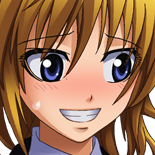Higanbana time~
So, right away I want to point out how dark Higanbana is in it’s presentation. The music is dark, the background is dark, the writing is dark… Even the character sprites have emphasis on shadows to be dark. And I don’t think it’s a coincidence that the first thing we hear once we get past the title screen is creepy ominous wind. It’s pretty clear that Higanbana wants to take the horror elements of Higurashi, and make them even darker and creepier.
Higanbana goes right into the deep end with a story about an incredibly unhealthy power dynamic between a teacher named Kanamori and his student, a girl named Marie. And by unhealthy power dynamic, I mean that he’s raping her in the bathroom every day after school, and in exchange would protect her from bullying.
Anyway, it’s screenshot time everyone!
And that’s really what’s so sad about Marie. Up until she meets Higanbana, she is able to mentally justify Kanamori’s actions because she’s so afraid of being blackmailed by him, or being bullied by her peers. She’s essentially the perfect target because everyone around her isolated her and forgot her.
She doesn’t realize until after talking with Higanbana that the social pressure hurts Kanamori’s reputation even more, and that she could have used that to her advantage while she was still alive. But at the same time, she couldn’t reach out for help. No one was willing to ever listen to her story, instead thinking of her as a ghost.
She hoped until the bitter end that someone would listen to her story and get her the help she needed. Kanamori stole what remained of her dignity from her, and then eventually stole her life. Even in death, he took her only hope of redemption by attempting to become Mesomeso himself. But in the end, Marie gets her happy ending and becomes the 8th member of the school’s youkai.
I also want to point out that I loved that when Kanamori was first talking about murdering Marie, that this song played. But then, the same song came back when Marie first started talking about becoming Mesomeso, and getting her revenge once she’s dead. It’s as if this BGM is the literal sounds of their desperation and downward spiral into insanity.
The song that plays when Higanbana herself makes an appearance is also beautiful. It’s elegant, yet mystical. And it perfectly fits her character of being a cold, creepy, doll like girl. And you have to admit, that violin is amazing! I’d love it if someone did a full blown musical analysis of Higanbana’s music. One of our newer members, @Arietta has been doing a fantastic job analyzing some of Umineko’s music over in the 07th Expansion music thread. Say, @Arietta, do you want to give Higanbana a shot? I’d love to read what you have to say about the music in Higanbana.
And to answer your question, @pictoshark, I don’t think mesomeso could be localized? The problem is, it’s a sound. Mesomeso is the onomatopoeia of Marie’s cries… Maybe she could be called Moaning Marie? I have no idea, hahaha. 

